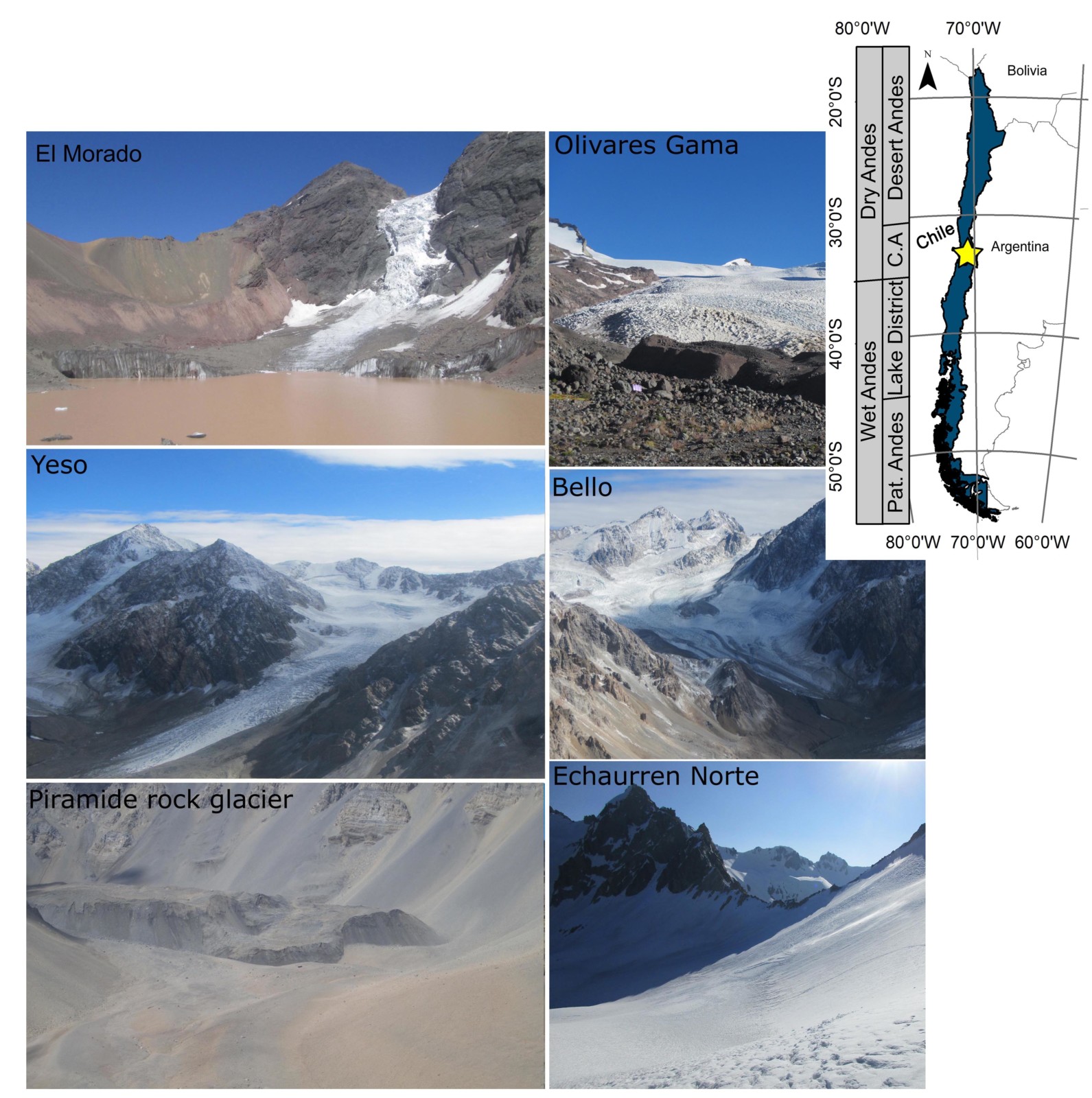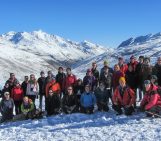
When you hear of Chilean glaciers, you probably think about the large glaciers of Patagonia. However, glaciers can be found further north in Chile as well (see this previous post). While the melting of the Patagonian glaciers mainly affects the global human population by contributing to sea level rise, the retreat of glaciers in central Chile affects the local human population directly in terms of water availability, and potential hazards. With this in mind, let us take you on a virtual trip to the Maipo River Basin in the Central Andes of Chile, part of the so-called “Dry Andes”…
Why the Maipo River Basin?
The Maipo River Basin (Figure 1, upper right) is a large river basin of almost 15,000 km2 in area that contains more than 800 glaciers, including debris-free, debris-covered, and rock glaciers (see Figure 1). This is also where the metropolitan region of Chile and its capital city, Santiago, are located. For the more than seven million inhabitants of Santiago, the Maipo River Basin is essential in terms of drinking water provision, agriculture, industry, hydropower, nature preservation, and recreation. To understand the impact of climate change on the Maipo River Basin, let’s visit the glaciers in “El Cajón del Maipo” (this is the colloquial name of the upper areas in the Maipo River Basin)!

Figure 1. The location of the Maipo River Basin in the Central Andes is shown as a yellow star in the upper right panel (C.A, according to Lliboutry, 1998). Panel of photos: Diversity of glaciers in the Maipo River Basin [Credits: Sebastián Vivero, Jorge Huenante and David Farías].
The Echaurren Norte Glacier, a reference for the glaciers in the Southern Andes
As a regular EGU Cryosphere Blog reader, you probably already know that glaciers are very sensitive to changes in climate. Glacier retreat and thinning due to global atmospheric warming has been observed in several mountainous regions during the last decades (see this, this, and this previous posts). Unfortunately, we know relatively little about glacier changes in the Central Andes of Chile. This is because the only glacier with a glaciological record longer than 40 years in that part of the Andes is the Echaurren Norte Glacier, a small glacier (0.17 km2 in 2015) located near Santiago, in the Maipo River Basin. The Water Directorate of Chile (DGA) has been measuring the glacier mass balance of Echaurren Norte continuously since 1975, and the World Glacier Monitoring Service (WGMS) uses this record as a reference for the entire Southern Andes (see Figure 2). These observations show a general decrease in the mass of the glacier interrupted by occasional short periods of increase or no change. These changes have recently been confirmed by new studies that used satellite and ground-based observations. These studies show that the glacier area has reduced by 65% and that the ice has thinned considerably between 1955 and 2015 and suggest that the glacier might disappear in the coming years, following the fate of other small Andean glaciers. Among other various impacts, its disappearance creates the need for a new reference glacier in the Southern Andes.

Figure 2. (a) Cumulative glacier mass balance (decrease) and area change of Echaurren Norte Glacier. (b) Shows the original stakes (measurement points) installed in 1975 and the current stakes. Background image corresponds to the aerial photograph in 1955 (Original aerial photographs provided by IGM) [Credit: David Farías].
What about the other glaciers in the Maipo River Basin?
Using several different digital elevation models generated from aerial photographs from the 1950s and modern satellite observations, we analyzed the mass balance of all glaciers in the Maipo River Basin from 1955 to 2013/15. We found that glaciers predominantly lost mass in our study period, but with some spatial and temporal differences between the main sub-basins. It has been shown that the glacier mass was positive or near-neutral in the 2000s, likely due to several wet years (more snow) caused by a positive phase of the El Niño Southern Oscillation. However, since 2010, this region has been affected by a sequence of dry years with annual rainfall deficits ranging from 25 to 45 %. This drought has been described as unprecedented in the historical record, due to its duration and spatial extent, and it has strongly impacted river flow, reservoir volumes, groundwater, evapotranspiration and ecosystems of the region. Since 2010, we see that ice thinning rates increased considerably compared to previous decades (the thinning rates almost tripled in some cases!). The increased thinning rates have been observed for both debris-covered and debris-free glaciers, but the magnitude of the increase in thinning rates is less pronounced for debris-covered than for debris-free glaciers, suggesting that the debris on the glacier can reduce the thinning to a certain extent.

Figure 3: The reconstruction of annual ice melt from glaciers in the Maipo River Basin in the period 1955-2016. The peaks highlighted in red show a decreasing sequence of maxima caused by the reduction of the ice volumes. On the right axis, we set the ice melt estimated for 1968 (the driest year on meteorological record) as 100 %. Ice melt units are normalized by the Upper Maipo River Basin area (~4800 km2) [Credit: Álvaro Ayala].
What is the impact of glacier retreat on the availability of water resources?
As glaciers retreat in response to climate change, large changes in meltwater production, which is an essential water resource, can be expected. Using a glacio-hydrological model, we found that glacier meltwater production has decreased over the last decades due to both a decrease in snowfall and a reduction of the ice volume available for melt. As a consequence of the ice volume reduction, total ice melt has consistently decreased since 1968, which is the driest year on record (Figure 3). Additional simulations show that the glaciers are still out of equilibrium with the current climate, and they will therefore continue retreating in the future, even without further warming. This further retreat will not only impact freshwater provision, but will also create additional challenges, such as the formation of new lakes.
Formation of new lakes in the Central Andes
As glaciers retreat, meltwater is impounded in the depression between the ice front and the abandoned moraine ridges (see this previous post). These lakes are called proglacial lakes and are a matter of increasing concern in mountain regions around the world because they exacerbate glacier thinning and retreat, and increase the risk of Glacial Lake Outburst Floods (GLOF). A recent inventory estimates that, in 2016, there were more than 100 of such lakes in the Central Andes of Chile. In an additional study, we conducted a detailed study of one of the most iconic glaciers of the Maipo River Basin, El Morado Glacier and its proglacial lake. Here, we found that the proglacial lake started to develop in the early 1950s, storing around 3.6 million m3 by 2017 (Figure 4). Although urban areas are far from the glaciers, there are a number of small villages and critical mountain infrastructure that might be endangered. As the assessment of GLOF hazards requires a good quantification of the lake’s water volume, it is important to obtain precise measurements of glacial lake depth and monitor its changes.

Figure 4: Growth in the proglacial lake at El Morado Glacier since 1955 [Credit: Farías et al., 2020].
To summarize
Climate change is posing serious challenges around the world. In this context, the Maipo River Basin and the Central Andes is a great example of how glacier retreat impacts on water availability and potential hazards. In our studies, we took advantage of the historical information, modern satellite and ground-based observations, and numerical modelling to provide reliable quantification of past, present and future glacier changes. We have added a missing piece of the current glacier status of the central Andes of Chile. Although our results showed dramatic glacier changes, they also provide a baseline information over this relatively sparsely investigated region. This is especially true now that the demand for water resources has been considerably increasing during the last decades, and a detailed knowledge about the current glacier status is needed for water managers and stakeholders for the generation of mitigation and adaptation strategies. The latest IPCC report highlighted that the worldwide glacier decline is globally affecting physical, biological and human systems. For that reason, we will continue and strengthen our glacier monitoring to understand and predict future changes in the Chilean Andes.
Further reading
- Farías-Barahona, D. et al. (2019): Geodetic Mass Balances and Area Changes of Echaurren Norte Glacier (Central Andes, Chile) between 1955 and 2015. Remote Sens, 11, 260, doi: 10.3390/rs11030260.
- Farías-Barahona, D. et al. (2020): A near 90-year record of the evolution of El Morado Glacier and its proglacial lake,Central Chilean Andes. Journal of Glaciology, 1-15. doi: 10.1017/jog.2020.52.
- Ayala, Á. et al. (2020): Glacier runoff variations since 1955 in the Maipo River basin, in the semiarid Andes of central Chile, The Cryosphere, 14, 2005-2027, doi: 10.5194/tc-14-2005-2020.
- Braun, M. et al. (2019): Constraining glacier elevation and mass changes in South America. Nat. Climate Change 9, 130-136, doi:10.1038/s41558-018-0375-7.
- Bravo, C. et al. (2017): Assessing glacier melt contribution to streamflow at Universidad Glacier, central Andes of Chile, Hydrol. Earth Syst. Sci., 21, 3249-3266, doi: 10.5194/hess-21-3249-2017.
- Dussaillant, I. et al. (2019): Two decades of glacier mass loss along the Andes. Nat. Geoscience, 12, 802-8, doi: 10.1038/s41561-019-0432-5.
- Masiokas, M.H. et al. (2020): A Review of the Current State and Recent Changes of the Andean Cryosphere. Front. Earth Sci. 8:99, doi: 10.3389/feart.2020.00099.
- Schaefer, M. et al. (2020): Surface energy fluxes on Chilean glaciers: measurements and models. The Cryosphere 14, 2545-2565, doi: 10.5194/tc-14-2545-2020.
- Did you know… the Andes are so cryo-diverse?
- Did you know? – Proglacial lakes accelerate glacier retreat!
Edited by Clara Burgard and Marie Cavitte
 David Farías-Barahona is a PhD student at the Friedrich-Alexander-Universität Erlangen-Nürnberg, Germany. He is working on the project “Detailed quantification and interpretation of glacier elevation and mass changes in the Southern Andes and South Georgia”. He tweets as @DavidFariasB.
David Farías-Barahona is a PhD student at the Friedrich-Alexander-Universität Erlangen-Nürnberg, Germany. He is working on the project “Detailed quantification and interpretation of glacier elevation and mass changes in the Southern Andes and South Georgia”. He tweets as @DavidFariasB.
 Álvaro Ayala is a postdoc at the Centre for Advanced Studies in Arid Zones (CEAZA), La Serena, Chile. His current research focuses on the runoff contribution from the cryosphere in dry mountain regions. He tweets as @alvaro__ar.
Álvaro Ayala is a postdoc at the Centre for Advanced Studies in Arid Zones (CEAZA), La Serena, Chile. His current research focuses on the runoff contribution from the cryosphere in dry mountain regions. He tweets as @alvaro__ar.




